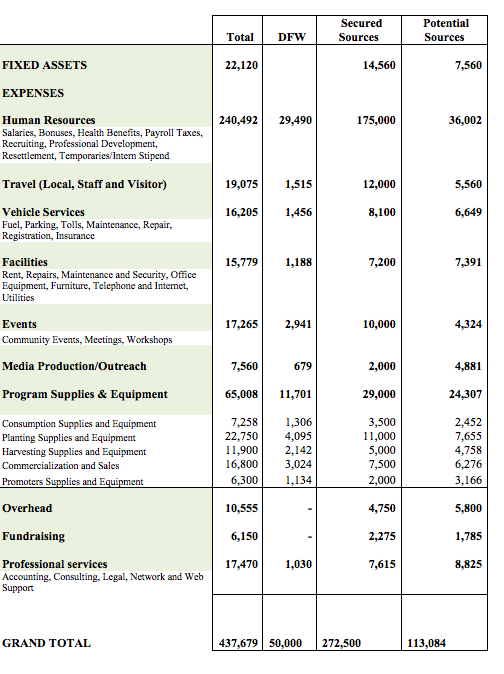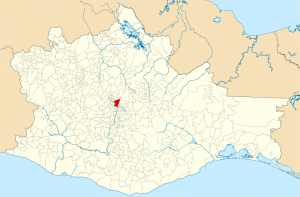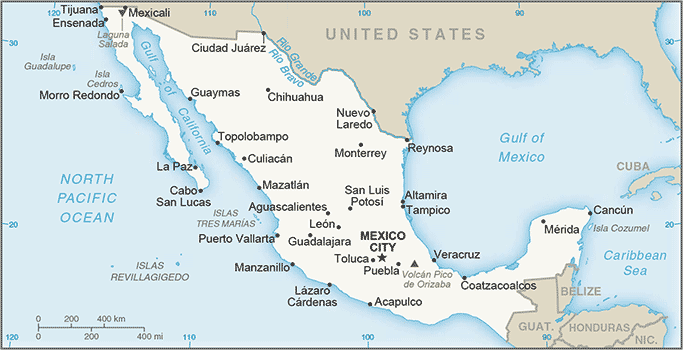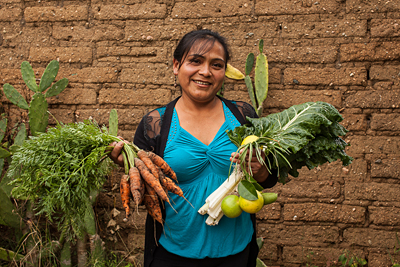
Mission
Puente a la Salud Comunitaria (Bridge to Community Health) contributes to food sovereignty and advances the health and well-being of rural communities in Mexico by promoting the cultivation, consumption and commercialization of amaranth.
Life Challenges of the Women Served
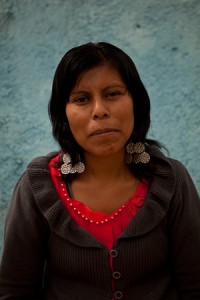 Rural Oaxacan families are negatively affected by malnutrition and obesity. Some 27 percent of Oaxacans suffer from food scarcity and 36 percent of children are undernourished.
Rural Oaxacan families are negatively affected by malnutrition and obesity. Some 27 percent of Oaxacans suffer from food scarcity and 36 percent of children are undernourished.
In the communities Puente serves, 90 percent of families report not having enough food to feed their families. Childhood malnutrition results in an 8 – 12 times greater chance of health-related illness, including obesity, throughout the lifespan as well as lower cognitive development. The paradox of malnutrition and obesity is largely due to communities’ reliance on imported, inexpensive and unhealthy processed foods.
Women, with relatively few economic opportunities and minimal ability to increase their local food production, have little power to respond to this crisis of nutrition. The average Oaxacan woman does 85 – 95 percent of unpaid domestic labor, limiting their economic resources. In terms of farming, women are less likely to use modern inputs such as improved seeds, fertilizers, pest control measures and mechanical tools. They also receive less credit and often do not control their families’ credit. If the world’s women farmers had the same access to resources as men, 150 million people could be lifted out of poverty, according to the Food and Agriculture Organization of the United Nations. A crop yield gap of about 20 – 30 percent between male and female farmers is largely due to differential access to resources and inputs. Due to this large gender gap in agriculture, women are unable to leverage sufficient resources.
The Project
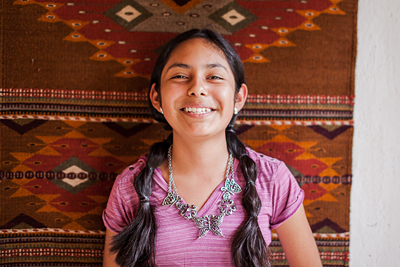 The goal of Puente is to empower rural Oaxacan women to farm amaranth (a highly nutritious local grain crop), improve family nutrition and health and form microenterprise groups to create jobs and economic opportunities locally.
The goal of Puente is to empower rural Oaxacan women to farm amaranth (a highly nutritious local grain crop), improve family nutrition and health and form microenterprise groups to create jobs and economic opportunities locally.
This program will give rural women and girls opportunities to bridge the gender gap, become healthier, play a larger role in economic decision-making and work their way out of poverty.
Amaranth is a pseudo-cereal with remarkable potential; both leaf and grain amaranth are nutrient-rich food sources, and the plant resists drought, allowing farmers to adapt to difficult growing conditions. The current market price is considerably higher than that for other grains, offering economic opportunities for farmer families. The nutritional, agro-ecological and local economic opportunities make amaranth a remarkable opportunity for community development.
Puente seeks to empower marginalized women to overcome economic limitations and improve their health by offering them novel opportunities through the consumption, production, and commercialization of amaranth.
This project will directly benefit 1,055 women and girls and indirectly benefit 2,000 women and girls in rural indigenous communities in Oaxaca, Mexico. The project seeks to promote auto-organization of community groups and networks supported by locally-based community promoters to ensure sustainability and local leadership.
Project objectives:
- 225 farmers learn to grow amaranth using agro-ecological methods through a series of workshops and technical follow-up and they participate in farmer-to-farmer exchanges.
- 540 women increase their consumption of amaranth to foster improved health and nutrition through 20 healthy cooking and nutrition workshops that benefit 300 women, eight summer nutrition programs that benefit 160 women and girls, and amaranth exchange vouchers that benefit 80 marginalized women.
- 16 amaranth microenterprise groups strengthen their organization and increase sales by 75 percent, directly benefitting 50 women.
- two Regional Amaranth Networks strengthen their organization and 85 percent of communities that Puente serves are members of the Regional Amaranth Networks
- 480 high school students learn about healthy nutrition and investigate their local food systems, directly benefitting 240 young women.
- 3,000 members of the general public participate in Amaranth Day.
Puente supports the agro-ecological production of amaranth through a series of workshops, farmer-to-farmer exchanges and training activities. Farmers increase the productivity from their harvests over time, owed to accumulated experience with the crop. Over the course of the growing cycle, workshops include planting techniques, maintenance, plant nutrition, organic pest management and harvesting. Puente promotes agro-ecological methods such as the use of local, natural resources for soil preparation and conservation. The strategy then focuses on training farmers in appropriate technology for harvesting, processing, and commercializing amaranth for the maximum value added.
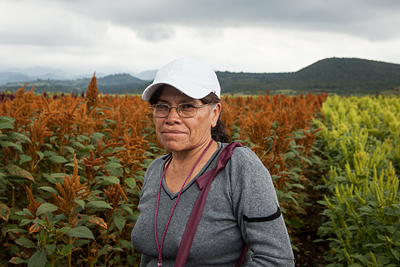 Puente works primarily with girls and young women youth ages 10 – 24.The average income is $4,000 annually, well below the national average of $7,000. While most communities have a health clinic, they are often understaffed and lacking critical medicine and supplies
Puente works primarily with girls and young women youth ages 10 – 24.The average income is $4,000 annually, well below the national average of $7,000. While most communities have a health clinic, they are often understaffed and lacking critical medicine and supplies
Puente’s aim for its nutrition initiative is primarily for pregnant and lactating women and the mothers and caretakers of children under five – the groups most vulnerable to the devastating, long-term effects of malnutrition. Puente’s approach seeks to attend the diversity of challenges that the target population faces by offering initiatives to decrease early age malnutrition and improve unhealthy eating habits. In addition, Puente with mothers to increase their knowledge of individual and family diet and nutrition.
Healthy Nutrition and Cooking Workshops emphasize the importance of including amaranth in a healthy diet. These are complemented by eight Summer Nutrition camps, which bring together a group of 20 mothers with undernourished children recommended by the health clinic. The mothers make breakfast and lunch with corn, amaranth, beans and local fruits and vegetables during 21 days, while the children participate in activities facilitated by volunteers with a focus on health and nutrition. This intensive summer camp helps to create and reinforce healthy cooking and eating habits and forms the base for a healthy diet. At-risk pregnant women and mothers with young children under five participate in nutrition workshops and receive vouchers called “Tzoallis” that they can exchange for amaranth seed, amaranth cereal and amaranth flour. The goal of the project is to achieve that 5 percent of the volume of amaranth seed in the region is emitted in the form of Tzoallis, and that they serve as a local exchange currency, building relationships and social capital for marginalized women.
Puente assists in the formation of community-based groups that create and sell products with amaranth to increase local availability and generate economic opportunities. Training includes group organization, production processes, commercialization and sales, legal constitution, resource management, and integration of groups, and lead marketing campaigns that promote the consumption of microenterprise products in schools, health centers, fairs, events and other important spaces. Puente accompanies processes of self-organization of two Regional Amaranth Networks that consist of farmers, mothers’ groups and microenterprise groups by providing training on consolidation of networks, integration of actors along the value chain, transparent leadership and governance, resource and project management, legal constitution, links with strategic actors including local authorities, markets and regional, state and national institutions.
Youth are engaged through semester-long food sovereignty work with twelve secondary schools, training teachers on themes of nutrition, agriculture and conducting workshops with teachers, students and local actors on these subjects. Many schools choose to plant their own amaranth farm, or create and sell healthy products with amaranth, during the semester.
Amaranth Day brings together amaranth farmers, mothers’ groups, microenterprise groups, students and others in a large event in Oaxaca City to create connections between rural producers and urban consumers, generate recognition and support for the work of small farmers and expand public knowledge about food sovereignty and the benefits of amaranth.
Millennium Development Goals
![]()
![]()
![]()
![]()
![]()
![]()
![]()
Questions for Discussion
- How do you think encouraging women to engage in agriculture can make an impact on future generations?
- Have you considered the paradox of malnutrition and obesity? Why do you think it exists?
- Why do you think Amaranth Day is an important part of sustaining women’s role in farming this crop?
How the Grant Will be Used
DFW’s donation of $50,000 will primarily cover programmatic costs related to the objectives of the project. The project includes pay for 15 staff members and 12 community promoters to directly teach 1,050 women and girls healthy lifestyles and farming methods for amaranth in the Valles Centrales and Mixteca Alta regions of Oaxaca, Mexico. Another 2,000 women and girls will be indirectly affected.
The project includes
- Agro-ecological amaranth production
- Healthy nutrition and cooking workshops
- The formation of microenterprise community groups
- Regional Amaranth Networks
- Youth and school initiatives
- Amaranth Day
Why We Love This Project/Organization
We love this project because of its focus on the specific needs of rural Oaxacan families, which include a lack of economic opportunities, as well as malnutrition and obesity. Puente’s project empowers women to farm with more access to soil inputs and knowledge, improve family nutrition and health and organize with other community members to create a sustainable model of knowledge transfer, jobs creation and economic opportunities locally.
Evidence of Success
Since 2003, Puente has carried out nutrition education and cooking workshops with more than 6,000 families in over 80 Oaxacan communities to incorporate amaranth and other healthy foods into the family diet. In 2014, they measured the following social impacts, which they believe are essential building blocks for human development and community development:
- 260 farmers planted enough amaranth to cover their family dietary needs on an increasing number of family amaranth plots.
- 15 percent of farming families have adopted amaranth in the family diet, consuming amaranth 2 – 3 times a week in three different forms.
- 470 marginalized women and children adopted amaranth into their diet, demonstrating positive nutritional outcomes.
- A 43 percent increase in income of farmer families through access to appropriate technology.
- 5 percent of farming families have adopted at least three agro-ecological methods to plant amaranth.
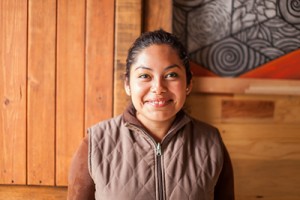 A growing demand for services caused Puente to expand to new communities in 2015. Puente’s radio communications efforts have begun to make a major impact, informing a potential audience of 8 million in Mexico City and Oaxaca about food sovereignty and prompting local community members to join programs. Puente held its third Amaranth Day in Oaxaca City in 2014, with the participation of over 2,000 people and 80 publications regarding the event in Oaxaca’s major television, radio and print news sources.
A growing demand for services caused Puente to expand to new communities in 2015. Puente’s radio communications efforts have begun to make a major impact, informing a potential audience of 8 million in Mexico City and Oaxaca about food sovereignty and prompting local community members to join programs. Puente held its third Amaranth Day in Oaxaca City in 2014, with the participation of over 2,000 people and 80 publications regarding the event in Oaxaca’s major television, radio and print news sources.
Puente continues to work to strengthen partnerships and coalitions in favor of food sovereignty and farmer families. Policy incidence has increased as Puente hosted a Value Chain Assessment that brought together more than 30 key stakeholders, from six different Mexican states. As a result of this conference, Puente worked with the Grupo Enlace Amaranto (Amaranth Group Network) to organize two large-scale amaranth conferences in 2014.
Voices of the Girls
 What fulfills me is working with my own seed. –MaryIn the communities it is difficult for men to see women getting ahead or having more knowledge than them, this is a challenge that I will overcome. — Irma
What fulfills me is working with my own seed. –MaryIn the communities it is difficult for men to see women getting ahead or having more knowledge than them, this is a challenge that I will overcome. — Irma
I have learned that you don’t necessarily need to depend on a man or another person to get ahead, you can do it yourself, and I believe this is extremely important. – Grecia
As women, we have the right to work and express their opinions. – Gloria
Nothing is impossible if you have the drive to get ahead in life. – Alma
As women, we have the responsibility to care for our families and this motivates us to participate and work for ourselves and our communities. – Maria
The empowerment and love of farming the land will allow women to improve our quality of life and the diet of our families. – Aracely
About the Organization
Puente was co-founded in 2003 by Kate Seely and Katherine Lorenz, two young American women volunteers who became fascinated by amaranth. Amaranth is native to Mesoamerica. Due to its nutritional value, economic potential and resistance to climatic conditions, amaranth is a viable alternative crop in developing countries. Working together with other Mexican organizations, they began to promote amaranth as an integral part of the solution to malnutrition in rural Mexico.
In 2009, Puente began the Eco Amaranth Program, working with small farmers to produce amaranth due to increasing demand for amaranth locally. In 2011, Puente began the Livelihoods initiative supported by the Ford Foundation which has now grown into the Social Economy Program, focusing on the formation of community based microenterprises and networks to generate value added from amaranth and strengthen local economies. In 2014, Puente conducted a participatory strategic planning process, redefining its organizational structure and making a renewed commitment to deepening the impact of its community work with food systems and food sovereignty. The organization now works with more than 600 rural families on the themes of health and nutrition, sustainable agriculture, local income generation and community organizing. Puente has also increasingly focused on establishing alliances and collaborations to expand program impact and influence public policy in favor of food sovereignty and community health.
Since its origins, Puente’s team has sought creative and effective strategies to incorporate amaranth into existing community dynamics, aiming for lasting social change, especially in the area of nutrition.
Where They Work
Puente serves the Valles Centrales and Mixteca Alta regions of Oaxaca, Mexico, located in the southern portion of the country. This indigenous area includes include Zapotec, Mixtec and Mestizo cultures.
According to Mexico’s tourism agency, Oaxaca (pronounced wa-hah-kah) is 5,000 feet above sea level and has a mild climate. It is located on the Pacific Ocean and has a tremendous amount of biodiversity.
Mexico’s federal republic government includes 31 states. Oaxaca is considered to be the third most economically marginalized of Mexico’s states. It has the third highest inequality index, with 30 percent of municipalities ranked as highly marginalized. Its 3.3 million residents are among some of the poorest in Mexico.
Mexico’s $1.3 trillion economy has become increasingly oriented toward manufacturing in the 21 years since the North American Free Trade Agreement (NAFTA) entered into force. Per capita income is roughly one-third that of the U.S. and income distribution remains highly unequal. Mexico has become the United States’ second-largest export market and third-largest source of imports.
A Closer Look
Income inequality in the developing world is nothing new, but in Mexico, the pace of modernization is producing two distinct levels of society with special rapidity. One group are the educated urbanites, with access to jobs in the industrialized northern and central regions. Where Mexico once exported raw materials for other countries to use in manufacturing, it is now building factories that send out Audis, airplanes, and electrical goods. The other side of society is made up of the citizens of what is known as Mexico profundo, those places – particularly in the southern states – where people cling to traditional ways of life and the stability of family-based livelihoods. The gulf between these two groups is enormous.
The Mixtecs of Oaxaca stand squarely in the second camp. The Mixtecs are one of Mexico’s indigenous peoples, afforded few opportunities and facing great discrimination. The United Nation’s International Fund for Agricultural Development stresses that the poverty rate among indigenous communities is much higher than that of non-indigenous areas, and the Office of the Commissioner on Human Rights expressed concern for the inequality of Mexico’s indigenous population “in all spheres of public life.” Like three-quarters of the world’s poorest, they live in sparsely populated rural areas, with limited access to adequate levels of reliable food sources, clean water, health services, or education.
Projects like those of Puente are an excellent way to reconcile the widespread desire to preserve traditional ways of life with the reality of urbanized Mexico. By introducing – or reintroducing – the cultivation of amaranth, Puente can enable communities to improve their food supply with a nutritious and sustainable crop while increasing their income through the sale of surplus yield or plant-based products. Grown in Mexico as many as 6,000 years ago, amaranth was not only a vital food source but was also an important component of Aztec rituals, and for this reason its cultivation was banned by the Spanish conquistadors. Amaranth is naturally drought- and weed-resistant and adapts well to unfavorable conditions. Its leaves are similar to spinach and can be eaten like a vegetable, and its protein-rich seeds can be used like a grain. Because amaranth is typically easy to grow and yields well, community-based enterprises can be established to make soap or oils from the seeds, allowing Mixtec families to remain in their villages rather than seeking employment elsewhere. Amaranth’s pre-Hispanic roots appeal to the Mixtecs’ deeply-felt desire to preserve traditional communities in their historic homeland; the market potential of this crop promises a pathway for the benefits of modernity to blend with an enduring Mixtec culture.
Source Materials
Sources: Puente a la Salud Comunitaria, US CIA Factbook
Sources: www.ifad.org; www.ohchr.org; “Of cars and carts,” by Huajuapan De León. The Economist, September 19-25, 2015. http://www.economist.com/news/briefing/21664939-despite-decades-reform-most-mexicans-are-still-long-way-wealth-and-modernity-cars; “Mixtecs Shed Pain of Oaxaca Poverty, “Patrick McDonnell, http://articles.latimes.com/1986-05-18/local/me-21007_1_mixtecs; “Amazing Amaranth,” by Scott Vlaun, April/May 2005, http://www.motherearthnews.com/organic-gardening/grow-amaranth.aspx

